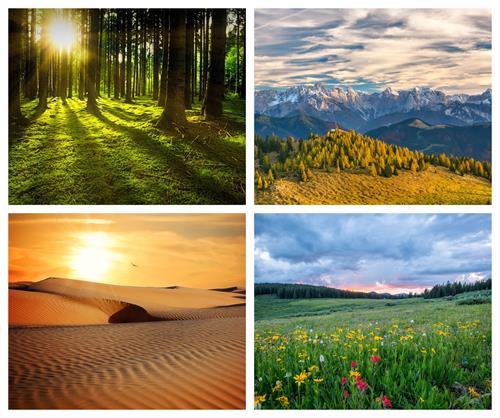
PUMPA - SMART LEARNING
எங்கள் ஆசிரியர்களுடன் 1-ஆன்-1 ஆலோசனை நேரத்தைப் பெறுங்கள். டாப்பர் ஆவதற்கு நாங்கள் பயிற்சி அளிப்போம்
Book Free DemoEcosystems can be classified based on various factors. The ecosystem can be classified based on formation, based on region, and based on their size.
Classification of ecosystems based on formation:
Ecosystems are classified as natural and artificial ecosystems based on how they are formed.
1. Natural ecosystems: Ecosystems like ponds, lakes, rivers, forests, etc., evolve naturally without the involvement of human beings. Such ecosystems are called natural ecosystems.

Lake
2. Artificial ecosystems: Ecosystems like zoos, gardens, parks, agricultural fields, aquariums, etc., are man-made ecosystems. Such ecosystems are called artificial ecosystems. These ecosystems are developed and maintained by humans.

Clockwise from Top-left: garden, park, agricultural paddy field, and aquarium
Classification of ecosystems based on region:
Ecosystems are also classified based on the region, i.e., on land or water. They are classified as:
1. Terrestrial ecosystem: Ecosystems that exist on land are known as terrestrial ecosystems.
Example:
Forests, grasslands, deserts, mountain and tundra ecosystems.

Clockwise from Top-left: Forests, mountains, desert, and grasslands
2. Aquatic ecosystem: Ecosystems that exist in water are known as aquatic ecosystems.
Example:
Freshwater ecosystems - ponds, lakes, rivers; marine water ecosystems - oceans and seas; and estuarine ecosystems.

Aquatic ecosystem

Classification of ecosystems based on their size:
Ecosystems can also be classified based on their size:
1. Micro ecosystem: Small scale ecosystems such as a pond, tree trunk, etc.

Pond
2. Meso ecosystem: Medium-scale ecosystems such as lakes, coral reefs, forests and sand dunes.

Coral reef
3. Macro ecosystem: Large scale ecosystem or an entire rainforest, also called a biome.

Rain forest
Reference:
https://commons.wikimedia.org/wiki/File:Early_Pond.jpg
https://commons.wikimedia.org/wiki/File:Coral_reef_09.jpg
https://commons.wikimedia.org/wiki/File:Rainforest_Creek_-_Fraser_Island.jpg